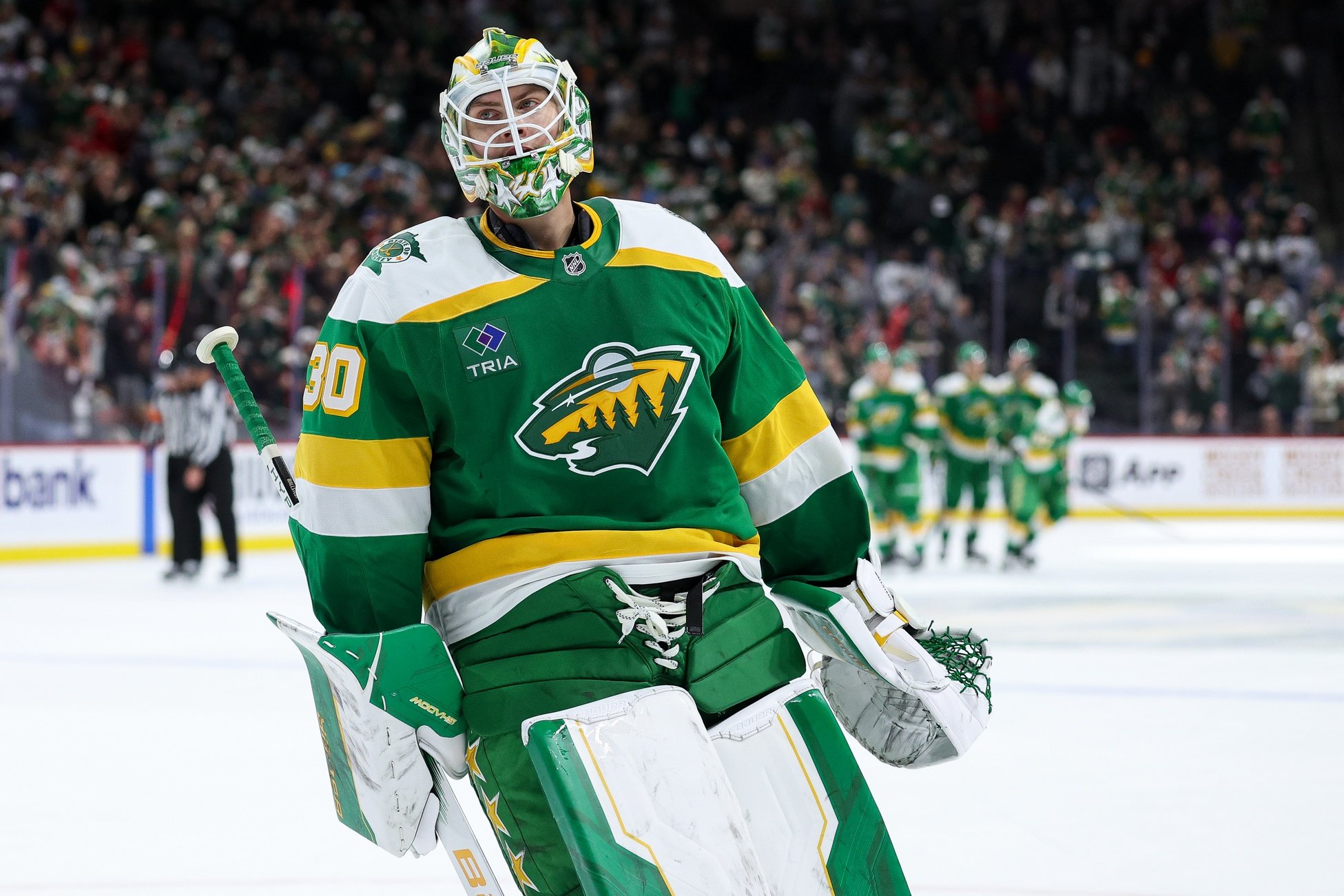Leaderboard
Popular Content
Showing content with the highest reputation on 11/25/2025 in Articles
-
There’s no one-size-fits-all approach when it comes to winning in the NHL. While there are lots of ways to win a hockey game, the best teams in the league generally have a well-developed identity. The Florida Panthers are relentless forecheckers with total buy-in from every player; the Colorado Avalanche blitz with pace and puck possession. The Minnesota Wild kind of lacked an identity until they started winning. With the duo of Filip Gustavsson and Jesper Wallstedt, Minnesota is becoming a team built on a high-end goaltending battery. Wallstedt is the league’s hottest goaltender, with three shutouts in his last four starts. Gustavsson has responded by also playing his best hockey of the season, with a .921 save percentage since the start of November. The hot streak by both goaltenders has been the driving force behind the Wild going 9-1-1 this month and turning around a difficult start to the season. Two goaltenders playing so well could lead to a few outcomes. There may be some calls to trade one of the goalies while they’re at peak value. There could be a goaltending controversy over who becomes the clear starter. Or you could also have two good goalies. With Wallstedt and Gustavsson on team-friendly contracts, the best option is for the Wild to have two high-end starters. Thankfully, John Hynes seems bullish on going with a rotation. "Right now, the way both guys are playing is for sure. That’s what we’ve done for the last few games. I would anticipate that moving forward," Hynes said. "I think there might be opportunities and stretches in the season where you possibly could ride one guy a little bit more than the other. But the way our two guys are playing and competing, it looks like a good recipe right now." The duo also agrees that their high-quality play is pushing them to be better. Jesper Wallstedt reflected on the dynamic recently, saying that it’s been a positive development for both of their games. “It makes both goalies compete, and both goalies get better from it, I think," Wallstedt said. "I think if both want to play as much as possible and kind of make the other one play a little less, I think that’s a healthy competition, and obviously, I know my role a little more coming into this year.” That healthy competition has obviously worked wonders for the duo. We’re looking at stats from a small sample size, but they don’t even scratch the surface of just how dominant the duo has been. Since November 1, the Wild lead the league in 5-on-5 save percentage with their goalies saving 96.53% of shots on goal. They’re second in the league in that stretch in high danger save percentage with an 88.89% mark. That accomplishment is especially impressive considering the Wild are giving up 26.56 scoring chances against per game, which is 12th-most in the league. In that same time frame, Wallstedt leads the NHL in GSAA/60 (1.52) while Gustavsson places 18th (.38) out of the 73 goalies who have made more than one start. They’re also both top 20 high-danger saves per 60 with Gustavsson in 14th place (6.87) and Jesper Wallstedt in 18th (6.65). Of course, Minnesota’s goaltending in the last month is challenging to count on long-term. Wallstedt isn’t going to continue shutting out three of every four opponents he faces. There’s a difference between a goaltending hot streak and being difficult to score against being a franchise’s defining identity. That identity comes when a team pairs strong goaltending with a stifling defensive structure that supports sustained success in limiting scoring. Fortunately, that’s perfect for the Wild. Minnesota has always been at its best when playing defensively sound hockey. Since the 2022-23 season, the Wild have surrendered the 3rd-least high-danger chances against (2645) in the league while ranking 11th-lowest in high-danger chances for (2851). Minnesota also ranks 3rd in expected goals against per game (2.79) and is a bottom-ten team in expected goals for per game (2.95). It may not be the most exciting brand of hockey, but the Wild are clearly constructed to limit chances and play the dreaded “low-event” style. Still, while it may not be glamorous, it’s actually the perfect fit for a team that is leaning into an identity as hard to score against, with two elite goaltenders. It’s a formula that has produced positive results in the past, especially for teams that need to get as much as they can out of a roster with limited scoring ability. The best example of a template the Wild could follow is emulating the success of the Barry Trotz-era New York Islanders. From 2018-19 through 2020-21, the Islanders were one of the best teams in the NHL. They reached the conference finals twice, including a Game 7 against the eventual champion Tampa Bay Lightning in 2020-21. New York’s calling card was low-event hockey with potent goaltending duos. During that time, the Islanders led the league in save percentage from their goaltenders and, like the Wild, ranked in the top ten in expected goals against per game (2.61) and in the bottom ten in expected goals for per game (2.65). The Islanders achieved that defensive excellence with sterling goaltending duos, including Robin Lehner and Thomas Greiss, Semyon Varlamov and Thomas Greiss, and Semyon Varlamov and Ilya Sorokin. During that time, every goalie had a positive goals saved above average rating, and none started more than 45 games in a season at any point in the stretch. While they never reached the Stanley Cup finals, the Islanders clearly delivered strong results and were a tough team to play against every time they took the ice. In the past, the Wild have played that low-event style, but haven’t gotten good enough goaltending to follow through on it fully. That’s the issue with playing slow hockey. When you’re giving up goals and can’t keep up with scoring, it’s a bad recipe for winning. But that equation finally looks different now. With Wallstedt and Gustavsson giving Minnesota the goaltending this system has always required, the Wild can finally commit to the identity of being a goalie team.2 points
-
Jesper Wallstedt is the story of the Minnesota Wild and their November turnaround. No shade to Filip Gustavsson (4-1-1 record, .921 save percentage this month), but "The Great Wall of St. Paul" is on an entirely different level right now. After Sunday's 32-save shutout in Winnipeg -- the second in franchise history! -- Wallstedt is now 5-0-0 in November, and 6-0-2 with a league-leading .935 save percentage for the season. We'd usually say "it's a small sample size" here, but throw it out the window. It's end zone dance time. Wallstedt deserves this one, especially since he was essentially left for dead as a top prospect based on... a small sample size. We know Wallstedt's story from last season. The Wild told him he'd get NHL time, only for salary-cap issues to immediately thwart that plan. However, what we perhaps overlooked was how much his lost season was affected by a handful of games at the beginning. Wallstedt finished his season with the Iowa Wild with an abysmal .879 save percentage in 27 games. However, the worst games almost exclusively happened in his first 10 starts. During that span (through November 24), he had given up five or more goals in five starts and had an .844 save percentage. It's like hitting .090 for six weeks to start a baseball season. There's just no coming back from that. The last 17 games weren't good, by any stretch of the imagination, but they weren't awful, either. Or at least, not that awful. After a two-week reset, Wallstedt went the rest of the way with an .890 save percentage. Mind you, that was all behind an Iowa Wild defense that, under Brett McLean, wasn't doing their goalies many favors. Context matters, and there was a lot that went into Wallstedt's awful year. He was overpromised and clearly struggling with that as he underdelivered, with little talent in the AHL to support him. But all the scouting community saw was the underdelivering. That's going to sound like a dunk on some really smart people, folks who talk to more scouts and watch more tape than anyone at this site does. It's not. Prospect evaluation is a tough gig: tracking the talent pools of 32 teams spread across a dozen or more leagues scattered around the world. Even the best are going to be wrong, and even the best can fall victim to recency bias. But looking at Wallstedt's overall trajectory, this is what he was supposed to be all along. Maybe not "Vezina-caliber numbers," but there was a reason many considered him the best goalie prospect in the world until a year ago. At every step of his development, Wallstedt handled himself well despite much older competition. That included two seasons in the AHL, sporting a .909 save percentage over 83 games behind the Iowa Wild's defense. A year where a goalie falls off the table entirely is always concerning, but the overall body of work gave a lot more to suggest that he'd be able to carve out a good NHL career. While we've just seen Wallstedt excel for eight games, it's been a scintillating performance at arguably the worst time to be a goalie in modern NHL history. Entering Sunday, the league-wide save percentage for the 2025-26 season was .897 -- down from .900 last year. You have to go back over 30 years to the 1993-94 season to find a worse save percentage (.895). Meanwhile, Wallstedt is looking like Dominik Hasek (.930 in 1993-94). His three shutouts also make up for 10.7% of the league total through November 24. Why was everyone out on this guy again? Maybe it's just the Wild fandom that makes seasons when a goalie loses it all seem normal. Darcy Kuemper couldn't buy a save as a young goalie in 2014-15 or 2016-17, and all he's done since leaving Minnesota is win almost 200 games and a Stanley Cup. Devan Dubnyk played his way to the AHL in 2013-14 at age 27, but managed to be a Vezina finalist the next year. It's also fair to caution about getting too high on eight games, and that will be the challenge for Wallstedt. Even when he succeeded for his first two seasons in the AHL, he'd go on extended hot streaks that were balanced out with elongated cold streaks. Wallstedt is going to have bad games and bad streaks, but how quickly he'll pull out of those tailspins will determine whether he's an eventual 60-game workhorse or merely a great tandem option. But that's in the future. For now, Wallstedt has rebuilt himself into a formidable netminder, taking starts from Gustavsson. Since Gustavsson took five straight starts from October 28 to November 6, Wallstedt has scratched out five starts to Gustavsson's three. It's a big vote of confidence, especially since Wallstedt has taken starts against the Eastern Conference Finalist Carolina Hurricanes and the Wild's nemesis in the Winnipeg Jets. It won't be surprising to see Gustavsson slot in against the Chicago Blackhawks on Wednesday, with Wallstedt getting the nod to face Nathan MacKinnon, Cale Makar, and the Colorado Avalanche. As quickly as he vanished from the map, Wallstedt is back on it.1 point





